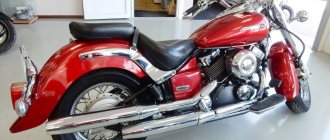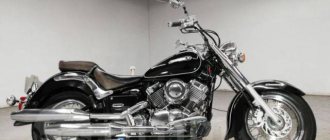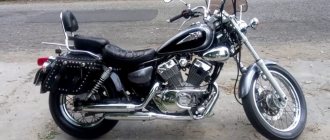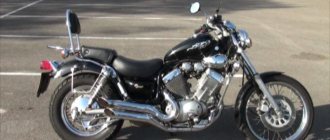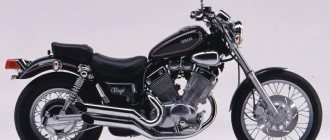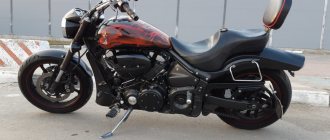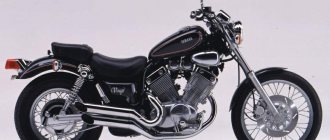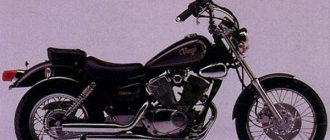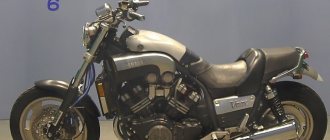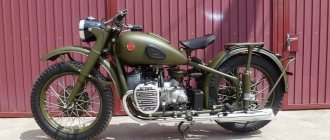Appearance
The Yamaha V-Max 1200 looks catchy, but within the framework of the classic style. It's immediately clear that this is a bike that strives to be similar to the most popular models of the mid-twentieth century. These were the cars that were considered the most interesting in terms of appearance. And there are reasons for this.
Like the golden classics of the last century, this model from Yamaha pays great attention to chrome parts, including the large exhaust pipe. The working parts of the motorcycle are clearly visible, which also does not go beyond the class. The wheels here are alloy. The seat is comfortable. The bike looks like a typical power cruiser, but was an innovation for its time.
Comfort
Since this is a power cruiser, the motorcycle, of course, is comfortable. It will be comfortable for people of relatively short stature. However, it is important to understand that this bike will not be comfortable for physically undeveloped people. The machine is quite heavy and requires a certain amount of muscle strength.
As for the ride, among cruisers and power cruisers the bike occupies a worthy position in terms of comfort. But, if a person is used to driving a sportbike or a motocross motorcycle, at first he will be unusual with such heavy equipment. It's not that the bike doesn't maneuver well, but the weight is still felt in every movement. Even after road motorcycles, it will be unusual to ride this model.
Dimensions and weight
This giant weighs quite a bit, and its length is considerable. However, the height of the saddle is not particularly high, and therefore short stature will not be a problem for the rider. The dimensions of this equipment correspond to the technical parameters. It cannot be said that large sizes are a plus or minus of the model, because this feature is typical for the entire class.
The dimensions are:
- height – 1160 mm;
- width – 795 mm;
- length – 2300 mm;
- wheelbase – 1590 mm;
- seat height – 765 mm;
- ground clearance - 145 mm;
- curb weight – 283 kg;
- Tank capacity – 15 l.
The tank volume is sufficient for more or less comfortable driving on country roads. However, this is not enough to drive far from civilization. However, power cruisers are not intended for this. The ground clearance of this model clearly shows that it is not suitable for off-road use.
Specifications
The Yamaha V-Max 1200 is distinguished primarily by its engine. The technical characteristics of the unit allow this heavy machine to move quickly and at the same time smoothly along the road.
Thanks to the chassis, it is possible to maneuver well at low, medium and high speeds. However, do not forget that this maneuverability is considered good for a power cruiser, it is still worse than that of lighter classes.
| Motor type | V-shaped, 4 cylinders, 4 strokes |
| Power | 145 hp |
| Torque | 123 Nm |
| Maximum speed | 233 km/h |
| Acceleration to 100 | 3.3 s |
| Fuel consumption per hundred | 6.8 l |
| Drive unit | gimbal |
| Transmission | five-speed |
| Frame | duplex steel |
| Rear suspension | pendulum, two shock absorbers, stroke 100 mm |
| Front suspension | telescopic fork, travel 140 mm |
| Rear brakes | single disc, 2-piston caliper, 282 mm |
| Front brakes | two discs, 4-piston calipers, 298 mm |
The cardan shaft is the optimal solution given the dimensions of this bike. Of course, this comes with a certain noise level. But for a power cruiser this is not something critical. It would even be strange if such equipment drove almost silently. We can say that the roar of the engine is an important stylistic component of the image of heavy bikes.
Price
New Yamaha V-max 1200 are no longer produced, so our market consists entirely of used models. Prices for these options vary greatly, depending on the condition. For a good version from more recent years, they can easily ask for $10,000-12,000. An important criterion affecting the price is the modification (depending on the country of delivery), the Californian version will be the most desirable.
Screenshot 1. Price for used Yamaha V-max 1200 on Avito
Owner reviews
Belokonov Konstantin (KOT)
Hello. In my opinion, there are two types of motorcycles for showing off and riding. Although the design of 1985 is noticeably behind modern ones, the V-MAX is not of the time. And it is for Riding. I think I have the right to say this because I have owned it since 2008. I’ve been a fan of motorcycling since 1987, and during this time I’ve driven everything from the domestic motorcycle industry to the Gold Wing. The true soul and heart of the engine is revealed on good country roads. It’s hard to describe in words, you have to feel it. It’s not for nothing that they write songs about MAX… Having bought this Mot, it’s impossible not to fall in love with it or hate a third. All my comrades who switched to V-MAX have never regretted it. And don’t believe anyone until you feel it yourself. I’d like to make a reservation right away. The Mot is only for guys who have a good experience in driving heavy vehicles and driving experience. In technical terms, my copy has only changed consumables for 7 years: Oil, pads, filters. The rear eats rubber quite well, 9-10 thousand before 15-17 thousand after all, the weight Now I installed the most expensive Meseller Marathon, let's try. I don’t recommend it for long-distance travelers, although I myself traveled to St. Petersburg with my wife and luggage without problems. Even if something breaks, everything is available and at low prices compared to modern counterparts. Well, something like this... Belokonov Konstantin
Pablo escobar
I want to share my opinion about another prominent representative in the world of motorcycles. This is a first generation Yamaha V-MAX 1200 motorcycle. This is a road worker, but in fact there is still no definitive definition for it. Many people consider it a chopper because it has a low stance, while others consider it a drag racing motorcycle because of its power. In general, there is no consensus, and this is not so important, in fact. A little about the filling of this beauty. Engine: V-shaped engine, volume 1200 cc. cm, 140 horsepower, liquid cooling, 4-piston, 4 valves per piston. Moreover, at low speeds only two valves per piston operate. I'll tell you in more detail below. In general, in my opinion, Yamaha designers have created an amazing motorcycle. Combined power and beauty into one whole. For a beginner who does not know this motorcycle, it will be an obvious mystery. The whole appearance of the V-MAX is so deceptive that many are simply lost. Let’s say the V-MAX’s fuel tank is not actually one, it’s there as if for beauty, but the real one is under the seat. The same goes for the huge air intakes on the sides. They are also only for beauty, since the engine is liquid cooled, but what brutality they give to this motorcycle! The V-MAX is not that difficult to drive, although it weighs about 300 kg, but due to its low center of gravity it is not difficult to hold. It steers easily. The acceleration is simply crazy, it can easily give odds to a sportbike. When the tachometer needle reaches 6700 rpm, the V-MAX turns on the so-called V-BOOST system, which connects a second pair of valves to each piston and the motorcycle gets a “second wind”. The engine simply explodes and a herd of 140 horses takes you far from your pursuers. The only negative about this motorcycle is the small volume of the fuel tank - only 15 liters. With such engine power, it lasts for 160 kilometers, but what unforgettable kilometers these will be! Filled with wild power, speed and a feeling of complete freedom!Pablo escobar
Irbis455
Like many other owners, I can’t decide which class this bike belongs to. My opinion is that this is still a chopper. Its engine is almost like a car's. The similarity is not only in volume but also in the high torque, especially at low speeds. It starts quite easily from second gear. The bike weighs almost three hundred kilograms and takes turns with ease. The suspension is quite soft, the motorcycle is not designed for Russian roads; it is better to avoid potholes, and if you hit them at high speed, there is a high probability of falling; in this case, it is better to jump off so that the bike flies forward, otherwise serious injuries cannot be avoided. It does not have a reverse gear, which causes some inconvenience when parking. Irbis455
History of changes
The Yamaha V-Max 1200 has undergone changes along its long production path. By 2007, the motorcycle was noticeably different from the concept that was presented at the beginning. But all changes are within the class and model, nothing inappropriate.
The story of change is this:
- In 1990, a new ignition was installed.
- In 1991, power was reduced due to new environmental regulations.
- In 1993, new carburetors and front forks were installed.
- For 2001 the bike is equipped with a new exhaust system.
- In 2004, a gasoline vapor trap was installed.
The bike did not immediately appear in all markets. For example, in Europe it became available only a year after the start of production, and in Japan only five years later. One way or another, the car is still popular and is unlikely to lose its relevance in ten or twenty years.
Yamaha Vmax 1200 Japanese muscles
In 1985, Yamaha released a brazen and brutal motorcycle. Born of acceleration racing, the V-Max was a mass of metal and chrome, instantly creating a cult following. But now, 23 years later, can this old man still command respect?
"Looks like this deadly 140 horsepower shopping cart is going to have a good time." With these parting words, the DK salesman handed me the keys to the motorcycle. These were not exactly the words that would have given me confidence. But still, this bike is 23 years old, so how difficult can it really be? About three hours later I was heading towards the hedge, eyes the size of saucers bulging, while the Vmax bobbed and jerked below me, trying to free the chassis from the knot in which its suspension was tangled.
I was only eight years old when the first Vmax was released, so I missed all the hype around it. At the time, I was more interested in the upcoming Optimus Prime Transformer comic than I was in a 140 hp muscle bike. effective power. In later years the name began to come up frequently in conversation, but since it was no longer in production, I had no reason to sit on it. However, with the advent of the new Yamaha Vmax, there is an excellent reason for this.
Usually, when it comes to a used motorcycle, especially one this old, finding a used model in good condition can be a complete nightmare. But not in the case of Vmax. One call to DK Motorcycles and sales manager Harry Mackay surprised me by telling me that he had just registered the new Vmax launched in 2008 and also had some great used bikes to offer. Although the bike was discontinued in Europe in 2004, the US market maintained demand for it, requiring Yamaha to produce the model until 2007, so new examples are still available for import. But at what price? A new bike costs £7,199, while the bike I decided to try, a 2000 model, cost around £5,000. That's not too far off from its £7,239 retail price. How does this work?
“The best selling bikes are the Hayabusa, R6 and Vmax,” Harry told me. — If I could get 10 new Vmax tomorrow, I would sell them all within a week. They have a lot of followers."
Rolling the bike out of the showroom and into the sunlight, I got my first chance to actually check out the Vmax. This bike still looks good, with an aggressive look dominated by a huge engine that really catches your eye. Monstrous yet displacing just 1,198cc, the V4 engine is styled for show, painted all black and then polished to a mirror finish on the edges of the radiator and shroud to create a certain look. The Vmax style is based on contrast. If the part is not black, then it is polished chrome, emphasizing the contours and elements of the motorcycle. So I initially thought that the fake carbon fiber covering of the fuel tank and rear fender was added later. But that's not true. In the last years of this model's life, Yamaha did produce motorcycles in this somewhat tacky style. But this is a motorcycle from a different era, and in the late 90s the visual effect of carbon fibers was all the rage. Turning the Vmax ignition key brought out a grunt deep within him. If you have ridden any Yamaha motorcycle with the YPVS sticker on it, then you are familiar with this sound. This is the sound of the valve block starting. Early European motorcycles never made this sound. For some reason, Yamaha Europe decided not to use V-Boost until 1996, literally neutering the bike to an effective 95 hp. instead of the declared 145 hp. Modifying these bikes was not difficult, but Yamaha Europe's short-sightedness led to an influx of bikes imported from the US, and the installation of second-hand V-Boost kits in Britain. Echoes of this story run through the life of Vmax in the UK. It took six years from its initial release in 1985 for the Vmax to be officially sold in England, and a further five years for it to reach full capacity. But, amazingly, the motorcycle sold. Imagine trying to sell an 11 year old FireBlade today. You simply won't have a chance. But the Vmax is no ordinary motorcycle.
V-Boost technology
The Vmax has four carburetors, one for each cylinder. The problem is that they are very small. It's good for the low end of the powerband, but not for the higher revs. Below 6000 rpm they supply fuel to each cylinder in the usual way, but from 6000 rpm everything changes. With the help of a solenoid, the damper is raised, which actually connects the cylinders in pairs. As a result, instead of receiving a mixture of fuel and air through one carburetor, each cylinder is served by two carburetors, and the amount of fuel entering the engine is effectively doubled (well, a little less, actually). And more fuel means more power. It's simple.
Getting on the Yamaha Vmax, I was actually a little nervous at first. I had heard all these stories before, and imagined the Vmax as some kind of acceleration racing demon that would try to rip my hands off at the slightest turn of the throttle, and at the same time it would turn until you forced it to do so. After about a mile I started to wonder where all these rumors came from. This is just a sweetheart - a big and strong good-natured guy.
On city streets, the Vmax proved to be perfect. He is calm and very pleasant to drive. The V4 engine produces a deep rumbling sound, and the rider's position, which initially felt odd due to the somewhat high footpegs and close-set handlebars, did not prove too awkward. Even its clutch is light. The bike handles quite honestly and even at low speeds you can feel how terrible the brakes are, which impressively manage to combine a complete lack of braking feel with a constant lack of stopping power. Pointing the bike out of town, I settled at a steady 50 mph (80 km/h), immersed in the Vmax feeling. Overall, it's an average bike with mood swings that start to affect the rider who feels tense while riding it, especially when people are looking at you. Despite its age, the Vmax is still an eye-catcher and its styling appeals to more than just motorcycle enthusiasts. There's something solid about it, in all its metal and moving parts, brazenly displayed to the world rather than hidden sheepishly under fairings.
Once outside the city, I stopped stopping at traffic lights. Having increased the speed, I decided to check the Vmax speed on a straight line without obstacles in the form of traffic lights. The first speed went to the second, and then to the third, and now we reached a speed of 80 mph (128 km/h). It's not terribly impressive by modern motorcycle standards, but the Vmax is still capable of picking up your skirts and running. Considering its engine is over 20 years old, that's quite impressive, and while it may not hold up against a modern GSX-R1000, it won't be far behind at speeds up to 80 mph. It must be remembered that when the Vmax was released, the sports bike class included the Suzuki GSX-R1100 with 128 horsepower and the Kawasaki RX1000 with 125 horsepower. Imagine what you heard back then about a 145 hp motorcycle with a V4 engine, and you will understand why people were eager to get their hands on this fire-breathing dragon. Everyone I'd spoken to had been enthusiastic about hitting 6,000 rpm (at which point the V-Boost kicks in), so I was expecting a power surge that never really came. Sure, there was an increase in power, but it didn't resemble the jump that some owners were talking about. The bike gets to that tachometer reading and goes further, but it's already so torque-laden that it seems to struggle even more. I think in 1985 motorcyclists used power within these limits without increasing it further. Considering it was designed in the 1980s, the bike is surprisingly powerful. But the impressions from the chassis are far from the same.
At Vmax, you don't turn it at high speed, you point it roughly in the right direction, wait for the chronic shaking to subside, and then pray you manage to turn it. I think Harry complimented it by calling it a "shopping trolley." In fact, everything is much worse. I remember a number of times when I was crossing the Peak District on a Yamaha and nearly ran off the road and became a curbside ornament. The suspension is terrible and even the cringe-inducing front brake is sufficient to force the matchstick-thin fork legs to bottom out if you hit a pothole while braking. It's a terrible feeling and one I don't want to experience again anytime soon. Even if the speed doesn't exceed 80 mph (128 km/h), I don't think any of the bikes I've ridden have been less controllable. But the Vmax I rode was an updated model with a “thick” 43 mm fork. The original version had a 40mm fork.
Having survived the Peak District, I was about 10 miles from the DK showroom when it started to drizzle. Moving away from traffic lights, the engine started to sound more strange, when shifting into second gear the sound persisted, and just when I thought the clutch might have slipped, the whole bike jerked to the side, and then, when the rear wheel caught on the road, the bike started to spin. On the other side. I didn't even increase the acceleration, but there was enough torque to lift the rear wheel off the road. In dry conditions at low speeds I was beginning to think this bike was a piece of cake, but at high speeds or in the rain it's a real beast and I'm really glad I managed to come back without injury. After spending a day at Vmax, I can see why it gets its reputation. Like many iconic motorcycles, the Vmax has one feature that stands out, while everything else requires major tweaking to function properly. This is a challenge for owners, which they gladly accept, and the cult of the motorcycle begins when specialized shops begin supplying components. After 23 years, the Vmax still has a great engine that wouldn't feel out of place even if it were released today. On the other hand, the chassis requires some work. But I think that's part of its appeal.
Modification Max
Henry Doyle has run Exactrep, a company specializing in Vmax accessories, for 15 years. Exactrep was the first stop for Vmax owners looking to modify their motorcycle.
The Vmax motorcycle has given birth to a legend, it is an icon that cannot be categorized. Some of our clients have modified it for touring, others for street racing. Vmax can be used in any way. Try the same with Blade. To be honest, they are not up to standard. It's a 70's chassis and an 80's engine. If Yamaha's engineers spent as much time on the chassis as they did on the opening seat to access the fuel filter, the chassis would be much better, and the OE tires are complete nonsense. The main problem is the suspension, the front is too soft and the rear is too hard. The first thing people do is they install a progressive spring and new shock absorbers, this immediately creates a noticeable difference. After this there are no restrictions. You can replace almost everything in the engine besides the cylinders! Supercharger compressors, larger diameter wheels, sets of larger cylinders, and basically anything else are very popular. I know owners who have spent £25,000 on their bike and could end up with 200bhp. actual power!
Adjusting the Max “There is a lot of praise and a lot of criticism around the Vmax engine. Yamaha claims 145 hp, but the engine typically produces an actual 110 hp, although it can be tuned. I'm not a fan of superchargers, but if you install a set of larger 1300 cc cylinders, new pistons, rebuild the engine, and gas supply, then you could very well get an actual power of 150 hp. But for this you will need from 4 to 5 thousand pounds. People complain about the handling, but this is a 20 year old bike, what do you expect from it? People buy it for its looks and its wonderful V4 engine.”
What do the owners say?
Judging by the video and photos, this car performs well in urban environments and wherever there is a more or less flat road. In reviews, owners say that the motorcycle is in no way suitable for off-road use.
This does not mean that the equipment is physically unable to cope with rough terrain, but it is unsafe: there is a high risk of damage.
According to the description of the owners in this or that review, it is more difficult to get spare parts for the motorcycle today than it was at the time of its release, in the 2000s. However, it is possible, so it cannot be said that maintenance will be expensive.
They also note that buying a used model itself is much more profitable than buying a new bike. About 140 thousand Russian rubles - that’s how much such a used motorcycle costs.
In conclusion, it is worth noting that the Yamaha V-Max 1200 is a legend in the power cruiser class. This machine is primarily suitable for connoisseurs of heavy equipment. If a person is accustomed to light motorcycles, then no matter how much he likes this heavyweight in appearance, he is unlikely to experience driving pleasure.
Repair and service
Wild power has its side effects. Yamaha V-max is the motorcycle whose engine could not be curbed. Excess power constantly tests the strength of the components and assemblies of the motorcycle.
Maintainability of Yamaha V-max 1200
The first thing to hit is the clutch; if you disassemble almost any used motorcycle, we will see serious signs of wear and overheating. Problems with the gearbox are mainly associated with the second gear, which often fails if engaged incorrectly.
When driving aggressively, the cardan also cannot withstand. The frame tends to burst and become deformed. The plastic star of the oil pump can also be called a serious flaw; if it fails, oil starvation occurs and, as a consequence, the inevitable death of the engine.
The large community of owners of this model saves the day; almost all of the problems described above have been solved, many of them can be predicted and treated in advance. Motorcycle maintenance has no special features as such.
